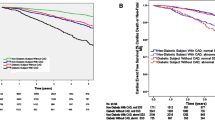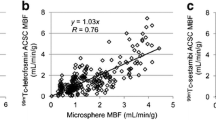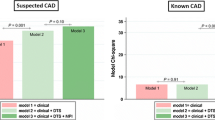Abstract
As the second term of our commitment to Journal begins, we, the editors, would like to reflect on a few topics that have relevance today. These include prognostication and paradigm shifts; Serial testing: How to handle data? Is the change in perfusion predictive of outcome and which one? Ischemia-guided therapy: fractional flow reserve vs perfusion vs myocardial blood flow; positron emission tomography (PET) imaging using Rubidium-82 vs N-13 ammonia vs F-18 Flurpiridaz; How to differentiate microvascular disease from 3-vessel disease by PET? The imaging scene outside the United States, what are the differences and similarities? Radiation exposure; Special issues with the new cameras? Is attenuation correction needed? Are there normal databases and are these specific to each camera system? And finally, hybrid imaging with single-photon emission tomography or PET combined with computed tomography angiography or coronary calcium score. We hope these topics are of interest to our readers.


Similar content being viewed by others
Abbreviations
- ACC:
-
American college of cardiology
- AHA:
-
American heart association
- CABG:
-
Coronary artery bypass grafting
- CAC:
-
Coronary artery calcium
- CAD:
-
Coronary artery disease
- CTA:
-
Computed tomography angiography
- DM:
-
Diabetes mellitus
- ECG:
-
Electrocardiogram
- ESC:
-
European society of cardiology
- EF:
-
Ejection Fraction
- FFR:
-
Fractional flow reserve
- HF:
-
Heart failure
- LV:
-
Left ventricular/left ventricle
- LOE:
-
Level of evidence
- MBF:
-
Myocardial blood flow
- MI:
-
Myocardial infarction
- MPI:
-
Myocardial perfusion imaging
- MRI:
-
Magnetic resonance imaging
- MFR:
-
Myocardial flow reserve
- PCI:
-
Percutaneous coronary artery intervention
- PET:
-
Positron emission tomography
- PROMISE:
-
Prospective multicenter imaging study for evaluation of chest pain
- RV:
-
Right ventricular/right ventricle
- SPECT:
-
Single-photon emission tomography
- SSS:
-
Summed stress score
- SRS:
-
Summed rest score
- SDS:
-
summed difference score
- TID:
-
Transient ischemic dilatation
References
Iskandrian AE. Myocardial perfusion imaging: Lessons learned and work to be done. J Nucl Cardiol. 2014;21:4–16.
Zaret BL, Strauss HW, Martin ND, Wells HP, Flamm MD Jr. Noninvasive regional myocardial perfusion with radioactive potassium—Study of patients at rest, with exercise and during angina pectoris. N Engl J Med. 1973;288:809–15.
Strauss HW, Zaret BL, Pieri P, Lahiri A. History corner: Antoine Becquerel. J Nucl Cardiol. 2017;24:1515–6.
Porter ME. What Is value in health care. N Engl J Med. 2010;363:2477–81.
Gibbons RJ. What is the evidence? A call for scientific rigor. J Nucl Cardiol. 2017;24:625–48.
Radford NB, DeFina LF, Barlow CE, et al. Progression of CAC score and risk of incident CVD. J Am Coll Cardiol Imag. 2016;9:1420–9.
Ford I, Shah AS, Zhang R, et al. High-sensitivity cardiac troponin, statin therapy and risk of coronary heart disease. J Am Coll Cardiol. 2016;68:2719–28.
Germano G, Kavanagh PB, Ruddy TD, et al. Same patient processing for multiple cardiac SPECT studies. 2. Improving quantification repeatability. J Nucl Cardiol. 2016;23:1442–53.
Lin X, Xu H, Zhao X, et al. Repeatability of left ventricular dyssynchrony and function parameters in serial gated myocardial perfusion SPECT studies. J Nucl Cardiol. 2010;17:811–6.
Zhou Y, Faber TL, Patel Z, et al. An automatic alignment tool to improve repeatability of left ventricular function and dyssynchrony parameters in serial gated myocardial perfusion SPECT studies. Nucl Med Commun. 2013;34:124–9.
Dilsizian V, Bacharach SL, Beanlands SR, et al. ASNC imaging guidelines/SNMMI Procedure standard for positron emission tomography (PET) Nuclear cardiology procedures. J Nucl Cardiol. 2016;23:1187–226.
Gewirtz H, Dilsizian V. Integration of quantitative PET absolute myocardial blood flow in the clinical management of coronary artery disease. Circulation. 2016;133:2180–96.
Tonino PA, De Bruyne B, Pijls NH, et al. FAME study investigators. Fractional flow reserve versus angiography for guiding percutaneous coronary intervention. N Engl J Med. 2009;360:213–24.
Schindler TH, Dilsizian V. PET-determined hyperemic myocardial blood flow: further progress to clinical application. J Am Coll Cardiol. 2014;64(14):1476–8.
Bateman TM, Dilsizian V, Beanlands RS, et al. ASNC/SNMMI position statement on the clinical indications for myocardial perfusion PET. J Nucl Cardiol. 2016;23:1227–31.
Johnson NP, Kirkeeide RL, Gould KL. Is discordance of coronary flow reserve and fractional flow reserve due to methodology or clinically relevant coronary pathophysiology? JACC Cardiovasc Imag. 2012;5:193–202.
Johnson NP, Gould KL. Physiological basis for angina and ST-segment change PET-verified thresholds of quantitative stress myocardial perfusion and coronary flow reserve. JACC Cardiovasc Imag. 2011;4:990–8.
Lee JM, Kim CH, Koo BK, et al. Integrated myocardial perfusion imaging diagnostics improve detection of functionally significant coronary artery stenosis by 13 N-ammonia positron emission tomography. Circulation. 2016;9:68.
Gould KL, Johnson NP, Bateman TM, et al. Anatomic versus physiologic assessment of coronary artery disease: role of coronary flow reserve, fractional flow reserve, and positron emission tomography imaging in revascularization decision-making. J Am Coll Cardiol. 2013;62:1639–53.
Dilsizian V. Transition from SPECT to PET myocardial perfusion imaging: A desirable change in nuclear cardiology to approach perfection. J Nucl Cardiol. 2016;23:337–8.
Maddahi J, Bengel F, Czernin J, et al. Dosimetry, bio-distribution, and safety of Flurpiridaz F 18 in healthy subjects undergoing rest and exercise or pharmacological stress PET myocardial perfusion imaging. J Nucl Cardiol. 2017 (Manuscript submitted for publication).
Yalamanchili P, Wexler E, Hayes M, et al. Mechanism of uptake and retention of 18F BMS747158-02 in cardiomyocytes: A novel PET myocardial imaging agent. J Nucl Cardiol. 2007;14:782–8.
Juneau D, Erthal F, Ohira H, et al. Clinical PET myocardial perfusion imaging and flow quantification. Cardiol Clin. 2016;34:69–85.
Kajander S, Joutsiniemi E, Saraste M, et al. Cardiac positron emission tomography/computed tomography imaging accurately detects anatomically and functionally significant coronary artery disease. Circulation. 2010;122:603–13.
Hajjiri MM, Leavitt MB, Zheng H, Spooner AE, Fischman AJ, Gewirtz H. Comparison of positron emission tomography measurement of adenosine-stimulated absolute myocardial blood flow versus relative myocardial tracer content for physiological assessment of coronary artery stenosis severity and location. J Am Coll Cardiol Imag. 2009;2:751–8.
Herzog BA, Husmann L, Valenta I, et al. Long-term prognostic value of 13N-ammonia myocardial perfusion positron emission tomography added value of coronary flow reserve. J Am Coll Cardiol. 2009;54:150–6.
Ziadi MC, Dekemp RA, Williams KA, et al. Impaired myocardial flow reserve on rubidium-82 positron emission tomography imaging predicts adverse outcomes in patients assessed for myocardial ischemia. J Am Coll Cardiol. 2011;58:740–8.
Murthy VL, Naya M, Foster CR, et al. Improved cardiac risk assessment with noninvasive measures of coronary flow reserve. Circulation. 2011;124:2215–24.
Ziadi MC, Dekemp RA, Williams K, et al. Does quantification of myocardial flow reserve using rubidium-82 positron emission tomography facilitate detection of multivessel coronary artery disease? J Nucl Cardiol. 2012;19:670–80.
Valenta I, Antoniou A, Marashdeh W, et al. PET-measured longitudinal flow gradient correlates with invasive fractional flow reserve in CAD patients. Eur Heart J Cardiovascular Imag. 2017;18:538–48.
Valenta I, Quercioli A, Schindler TH. Diagnostic value of PET-measured longitudinal flow gradient for the identification of coronary artery disease. JACC Cardiovasc Imag. 2014;7:387–96.
Mercuri M, Pascual TNB, Mahmarian JJ, for the INCAPS investigators group, et al. Findings from the IAEA (International Atomic Energy Agency) nuclear cardiology protocols study. JAMA. Intern Med. 2016;176:266–9.
Einstein AJ, Pascual TNB, Mercuri M, For the INCAPS investigators group, et al. Current worldwide nuclear cardiology practices and radiation exposure: results from the 65 country IAEA nuclear cardiology protocols cross-sectional study (INCAPS). Eur Heart J. 2015;36:1689–96.
Petretta M, Cuocolo A. Comparison of ESC and ACC/AHA guidelines for myocardial revascularization. Are the differences relevant? The European perspective. J Nucl Cardiol. 2017;24:1057–61.
Stirrup J, Velasco A, Hage FG. Guidelines in review: Comparison of ESC and ACC/AHA guidelines for myocardial revascularization. J Nucl Cardiol. 2017;24:1046–53.
Laskey WK, Feinendegen LE, Neumann RD, Dilsizian V. Low-level ionizing radiation from non-invasive cardiac imaging: Can we extrapolate estimated risks from epidemiologic data to the clinical setting? J Am Coll Cardiol Imag. 2010;3:517–24.
Shi L, Dorbala S, Paez D, et al. Gender differences in radiation dose from nuclear cardiology studies across the world. J Am Coll Cardiol Imag. 2016;9:376–84.
Zanzonico P, Dauer L, Strauss HW. Radiobiology in cardiovascular imaging. J Am Coll Cardiol Imag. 2016;9:1446–61.
Esteves FP, Raggi P, Folks RD, et al. Novel solid-state-detector dedicated cardiac camera for fast myocardial perfusion imaging: multicenter comparison with standard dual detector cameras. J Nucl Cardiol. 2009;16:927–34.
Duvall WL, Croft LB, Godiwala T, et al. Reduced isotope dose with rapid SPECT MPI imaging: Initial experience with a CZT SPECT camera. J Nucl Cardiol. 2010;17:1009–14.
Garcia EV. Physical attributes, limitations, and future potential for PET and SPECT 2012. J Nucl Cardiol. 2012;1:S19–29.
Fabio EP, Galt JR, Folks RD, et al. Diagnostic performance of low-dose rest/stress Tc-99m tetrofosmin myocardial perfusion SPECT using the 530c CZT camera: Quantitative vs visual analysis. J Nucl Cardiol. 2014;21:158–65.
Bailliez A, Blaire T, Mouquet F, et al. Segmental and global left ventricular function assessment using gated SPECT with a semiconductor Cadmium Zinc Telluride (CZT) camera: Phantom study and clinical validation vs cardiac magnetic resonance. J Nucl Cardiol. 2014;21:712–22.
Duvall WL, Sweeny JM, Croft LB, et al. Reduced stress dose with rapid acquisition CZT SPECT MPI in a non-obese clinical population: Comparison to coronary angiography. J Nucl Cardiol. 2012;19:19–27.
Oddstig J, Hedeer F, Jogi J, et al. Reduced administered activity, reduced acquisition time, and preserved image quality for the new CZT camera. J Nucl Cardiol. 2013;20:38–44.
Nudi F, Iskandrian AE, Schillaci O, et al. Diagnostic accuracy of myocardial perfusion imaging with CZT technology. Systemic review and meta-analysis of comparison with invasive coronary angiography. JACC. 2017;10:787–94.
Hindorf C, Oddstig J, Hedeer F, et al. Importance of correct patient positioning in myocardial perfusion SPECT when using a CZT camera. J Nucl Cardiol. 2014;21:695–702.
Miao L, Kansal V, Wells R, et al. Adopting new gamma cameras and reconstruction algorithms: Do we need to re-establish normal reference values? J Nucl Cardiol. 2016;23:807–17.
Duvall WL, Slomka PJ, Gerlach JR, et al. High-efficiency SPECT MPI: Comparison of automated quantification, visual interpretation, and coronary angiography. J Nucl Cardiol. 2013;20:763–73.
Harrington R, Walsh R, Fuster V. Hurst’s the Heart, 14th Edition: Two Volume Set. New York: McGraw-Hill Education; 2017.
SNMMI/ASNC/SCCT guideline for cardiac SPECT/CT and PET/CT 1.0., J Nucl Med. 2013; 54:1485-507. PMID: 23781013.
Rozanski A, Gransar H, Hayes SW, et al. Temporal trends in the frequency of inducible myocardial ischemia during cardiac stress testing: 1991–2009. J Am Coll Cardiol. 2013;61:1054–65.
Berman DS, Rozanski A. Value-based imaging: Combining coronary artery calcium with myocardial perfusion imaging. J Nucl Cardiol. 2016;23:939–41.
Engbers EM, Timmer JR, Ottervanger JP, et al. Prognostic value of coronary artery calcium scoring in addition to single-photon emission computed tomographic myocardial perfusion imaging in symptomatic patients. Circulation. 2016;9:e003966.
Berman DS, Wong ND, Gransar H, et al. Relationship between stress-induced myocardial ischemia and atherosclerosis measured by coronary calcium tomography. J Am Coll Cardiol. 2004;44:923–30.
Schenker MP, Dorbala S, Hong EC, et al. Interrelation of coronary calcification, myocardial ischemia, and outcomes in patients with intermediate likelihood of coronary artery disease: a combined positron emission tomography/computed tomography study. Circulation. 2008;117:1693–700.
Budoff MJ, Diamond GA, Raggi P, et al. Continuous probabilistic prediction of angiographically significant coronary artery disease using electron beam tomography. Circulation. 2002;105:1791–6.
Akincioglu C, Belhocine T, Gambhir S, et al. Complementary roles of low-dose SPECT-CT and high-resolution volume CT for detection of coronary artery disease. Clin Nucl Med. 2008;33:285–7.
Berman DS, Kang X, Slomka PJ, et al. Underestimation of extent of ischemia by gated SPECT myocardial perfusion imaging in patients with left main coronary artery disease. J Nucl Cardiol. 2007;14:521–8.
Di Carli MF, Dorbala S, Curillova Z, et al. Relationship between CT coronary angiography and stress perfusion imaging in patients with suspected ischemic heart disease assessed by integrated PET-CT imaging. J Nucl Cardiol. 2007;14:799–809.
Danad I, Raijmakers PG, Appelman YE, et al. Hybrid imaging using quantitative H215O PET and CT-based coronary angiography for the detection of coronary artery disease. J Nucl Med. 2013;54:55–63.
The SC. CT coronary angiography in patients with suspected angina due to coronary heart disease (SCOT-HEART): an open-label, parallel-group, Multi-centre trial. Lancet 2015; 385:2383-91.
Williams MC, Hunter A, Shah AS, et al. Use of coronary computed tomographic angiography to guide management of patients with coronary disease. J Am Coll Cardiol. 2016;67:1759–68.
Engbers EM, Timmer JR, Ottervanger JP, et al. Sequential SPECT/CT imaging for detection of coronary artery disease in a large cohort: evaluation of the need for additional imaging and radiation exposure. J Nucl Cardiol. 2017;24:212–23.
Chang SM, Nabi F, Xu J, et al. The coronary artery calcium score and stress myocardial perfusion imaging provide independent and complementary prediction of cardiac risk. J Am Coll Cardiol. 2009;54:1872–82.
Douglas PS, Cerqueira MD, Berman DS, et al. The future of cardiac imaging. Report of a think tank convened by the American College of Cardiology. JACC. 2016;9:1211–23.
Marwick TH, Chandrashekhar Y, Narula J. Training in multimodality CV imaging. Is there an inclusive model? JACC. 2016;9:1235–7.
Disclosure
Ernest V Garcia: Royalties from sale of medical software, shares of Syntermed. Rob S. Beanlands: Consultant: GE, JubilantDraxImage, Lanthues; Research Grants from JubilantDraxImage, Lantheus. Manuel Cerqueira: Consultant: Astellas Pharma USA, GE; Speakers Bureau: Astellas Pharma USA. Prem Soman: Grant funding to institution: Astellas Pharma; Advisory Board: Alnylam Pharma. Daniel S. Berman: Software Royalties from Cedars-Sinai Medical Center. Andrew J Einstein: Grant funding to institution: GE Healthcare, Philips Healthcare, Toshiba America Medical Systems. Advisory board: GE Healthcare. Fadi G. Hage: Grant support: Astellas Pharma, Novartis Pharma. Jeroen J Bax: The Dept of Leiden University Medical Center, The Netherlands, has received unrestricted research grants from Biotronik, Medtronic, Boston Scientific and Edwards Lifescience. Mehran M. Sadeghi: Consultant Bracco Research USA. Nagara Tamaki: Grant funding to institution: Nihon Medi-Physics Co Ltd. and Fuji-Film RI Pharma Co Ltd. Philipp A. Kaufmann: The Department of Nuclear Medicine, University Hospital Zurich holds a Research contract with GE Healthcare. Robert Gropler: Consultant Biomedical Systems. Sharmila Dorbala: Research grant Astellas Pharma; Stockownership GE. All others authors have nothing to disclosure.
Author information
Authors and Affiliations
Corresponding author
Rights and permissions
About this article
Cite this article
Iskandrian, A.E., Dilsizian, V., Garcia, E.V. et al. Myocardial perfusion imaging: Lessons learned and work to be done—update. J. Nucl. Cardiol. 25, 39–52 (2018). https://doi.org/10.1007/s12350-017-1093-7
Received:
Accepted:
Published:
Issue Date:
DOI: https://doi.org/10.1007/s12350-017-1093-7




